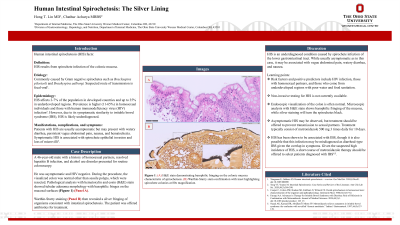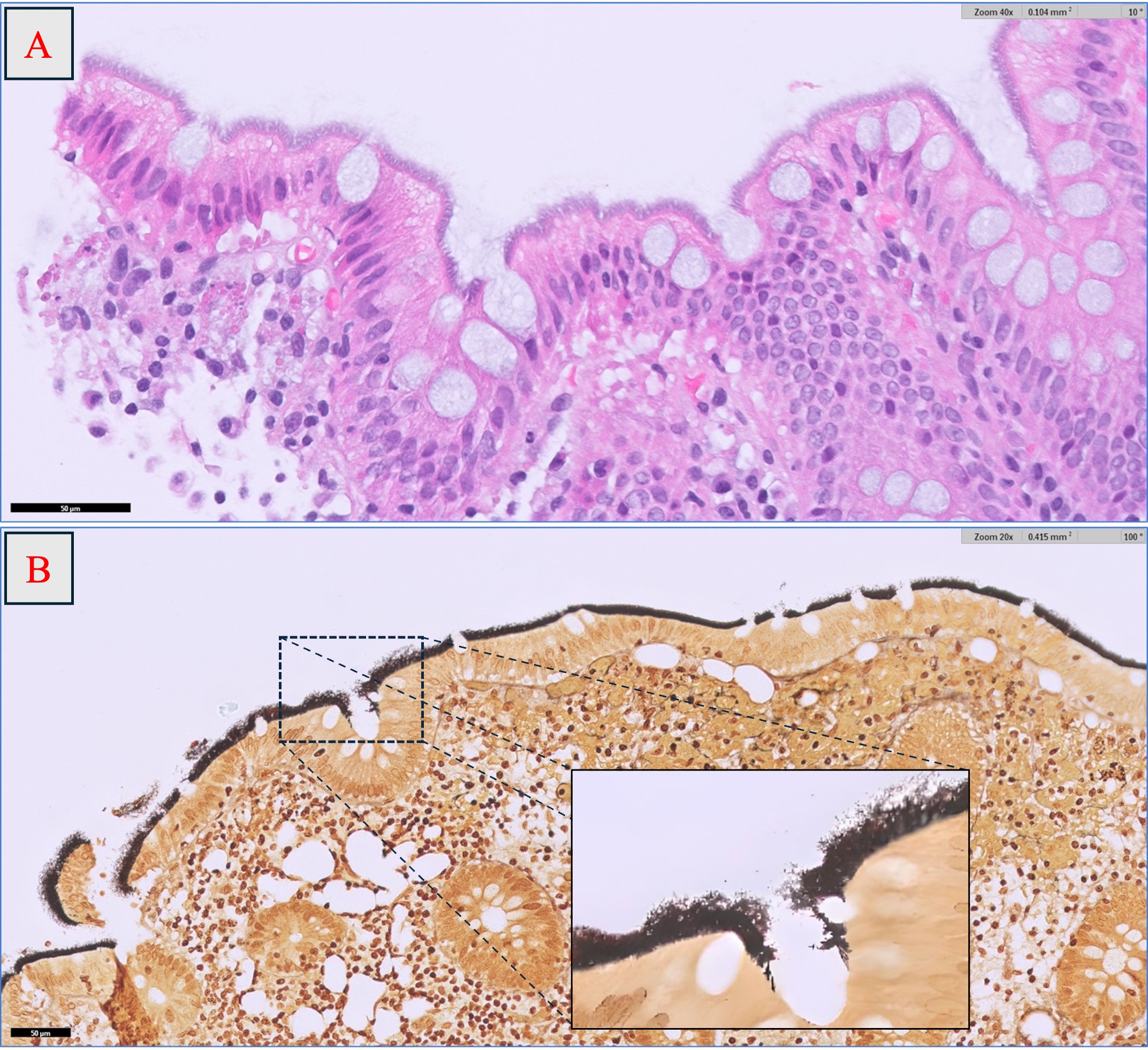Sunday Poster Session
Category: Colon
P0383 - Human Intestinal Spirochetosis: The Silver Lining
Sunday, October 27, 2024
3:30 PM - 7:00 PM ET
Location: Exhibit Hall E

Has Audio

Hong T. Lin, MD
The Ohio State University Wexner Medical Center
Columbus, OH
Presenting Author(s)
Hong T. Lin, MD, Chathur Acharya, MBBS
The Ohio State University Wexner Medical Center, Columbus, OH
Introduction: Human intestinal spirochetosis (HIS) results from the infection of the colonic mucosa with spirochetes such as Brachyspira pilosicoli and Brachyspira aalborgi. While often asymptomatic and discovered incidentally during colon cancer screening, HIS may cause persistent abdominal pain, hematochezia, nausea, and diarrhea. The route of transmission is typically fecal-oral, and diagnosis is made through microscopic analysis of colonic tissue. Common stains used include hematoxylin and eosin (H&E) as well as Warthin-Starry silver. No non-invasive testing is currently available; Brachyspira species are slow-growing, difficult to culture, and are often not detected by standard 16S rRNA sequencing.
Case Description/Methods: A 46-year-old male with a history of homosexual partners, resolved hepatitis B infection, and alcohol use disorder presented for routine colonoscopy. He was asymptomatic and human immunodeficiency virus (HIV) negative. During the procedure, the visualized colon was normal other than sessile polyps, which were resected. Pathological analysis with H&E stain showed tubular adenoma morphology with basophilic fringes on the mucosal surfaces (Panel A). Warthin-Starry staining (Panel B) then revealed a silver fringing of organisms consistent with intestinal spirochetosis. The patient was offered antibiotics for treatment.
Discussion: HIS is an underdiagnosed condition affecting 2-7% of the population in developed countries and up to 35% in underdeveloped regions. Prevalence is higher (11-65%) in homosexual individuals and those with HIV infection. Endoscopic visualization of the colon is often normal, while microscopic evaluation shows basophilic fringing of the colonic mucosa on H&E stain and highlighting of spirochetes on Warthin-Starry stain. Symptomatic HIS often occurs with epithelial invasion and is treated with metronidazole 500 mg three times a day for 10 days. Asymptomatic HIS, typically without mucosal invasion, may be observed but treatment should be offered to avoid transmission to sexual partners. HIS is significantly associated with irritable bowel syndrome (IBS), though further research is needed to determine if the relationship is causative and, if so, the direction of causality. Given the high incidence of HIS and its potential misdiagnosis as diarrheal-type IBS, a short course of metronidazole therapy may be offered to patients diagnosed with IBS in the appropriate setting.

Disclosures:
Hong T. Lin, MD, Chathur Acharya, MBBS. P0383 - Human Intestinal Spirochetosis: The Silver Lining, ACG 2024 Annual Scientific Meeting Abstracts. Philadelphia, PA: American College of Gastroenterology.
The Ohio State University Wexner Medical Center, Columbus, OH
Introduction: Human intestinal spirochetosis (HIS) results from the infection of the colonic mucosa with spirochetes such as Brachyspira pilosicoli and Brachyspira aalborgi. While often asymptomatic and discovered incidentally during colon cancer screening, HIS may cause persistent abdominal pain, hematochezia, nausea, and diarrhea. The route of transmission is typically fecal-oral, and diagnosis is made through microscopic analysis of colonic tissue. Common stains used include hematoxylin and eosin (H&E) as well as Warthin-Starry silver. No non-invasive testing is currently available; Brachyspira species are slow-growing, difficult to culture, and are often not detected by standard 16S rRNA sequencing.
Case Description/Methods: A 46-year-old male with a history of homosexual partners, resolved hepatitis B infection, and alcohol use disorder presented for routine colonoscopy. He was asymptomatic and human immunodeficiency virus (HIV) negative. During the procedure, the visualized colon was normal other than sessile polyps, which were resected. Pathological analysis with H&E stain showed tubular adenoma morphology with basophilic fringes on the mucosal surfaces (Panel A). Warthin-Starry staining (Panel B) then revealed a silver fringing of organisms consistent with intestinal spirochetosis. The patient was offered antibiotics for treatment.
Discussion: HIS is an underdiagnosed condition affecting 2-7% of the population in developed countries and up to 35% in underdeveloped regions. Prevalence is higher (11-65%) in homosexual individuals and those with HIV infection. Endoscopic visualization of the colon is often normal, while microscopic evaluation shows basophilic fringing of the colonic mucosa on H&E stain and highlighting of spirochetes on Warthin-Starry stain. Symptomatic HIS often occurs with epithelial invasion and is treated with metronidazole 500 mg three times a day for 10 days. Asymptomatic HIS, typically without mucosal invasion, may be observed but treatment should be offered to avoid transmission to sexual partners. HIS is significantly associated with irritable bowel syndrome (IBS), though further research is needed to determine if the relationship is causative and, if so, the direction of causality. Given the high incidence of HIS and its potential misdiagnosis as diarrheal-type IBS, a short course of metronidazole therapy may be offered to patients diagnosed with IBS in the appropriate setting.

Figure: Figure 1: (A) H&E stain demonstrating basophilic fringing on the colonic mucosa characteristic of spirochetosis. (B) Warthin-Starry stain confirmation with inset highlighting spirochete colonies at 80x magnification.
Disclosures:
Hong Lin indicated no relevant financial relationships.
Chathur Acharya indicated no relevant financial relationships.
Hong T. Lin, MD, Chathur Acharya, MBBS. P0383 - Human Intestinal Spirochetosis: The Silver Lining, ACG 2024 Annual Scientific Meeting Abstracts. Philadelphia, PA: American College of Gastroenterology.
